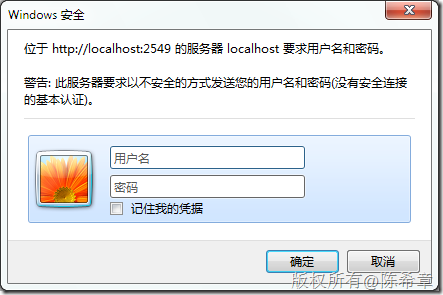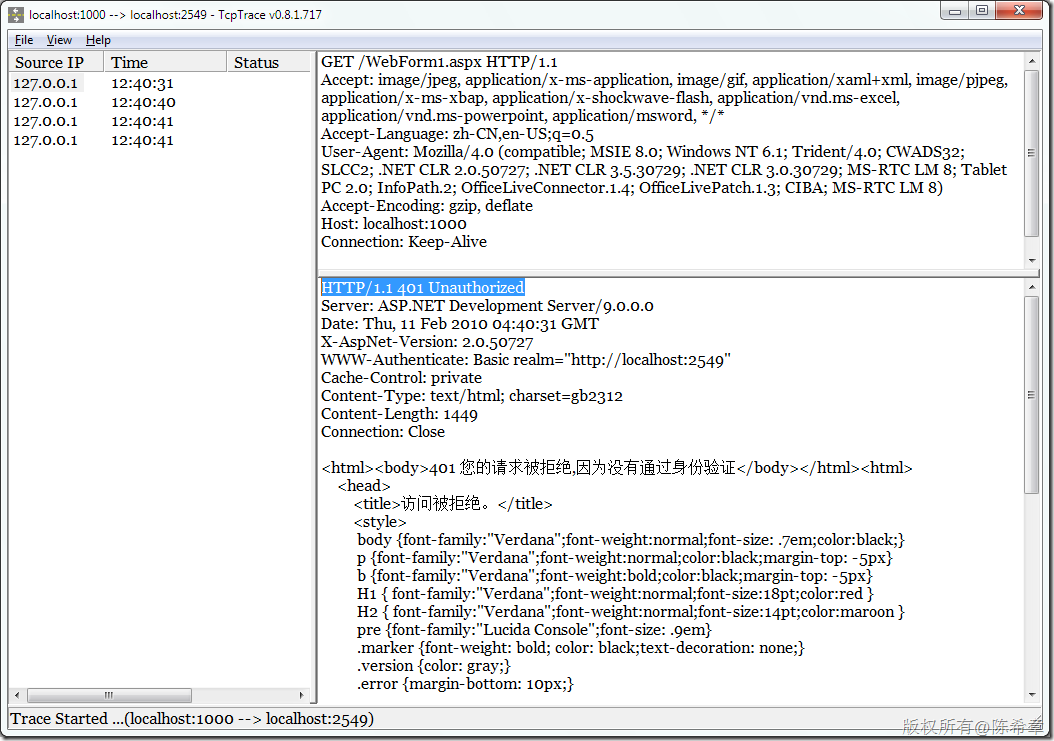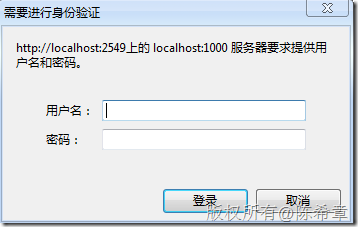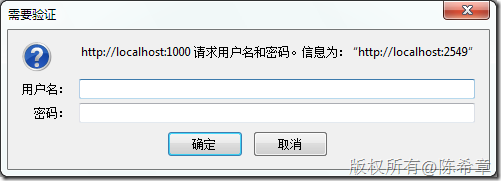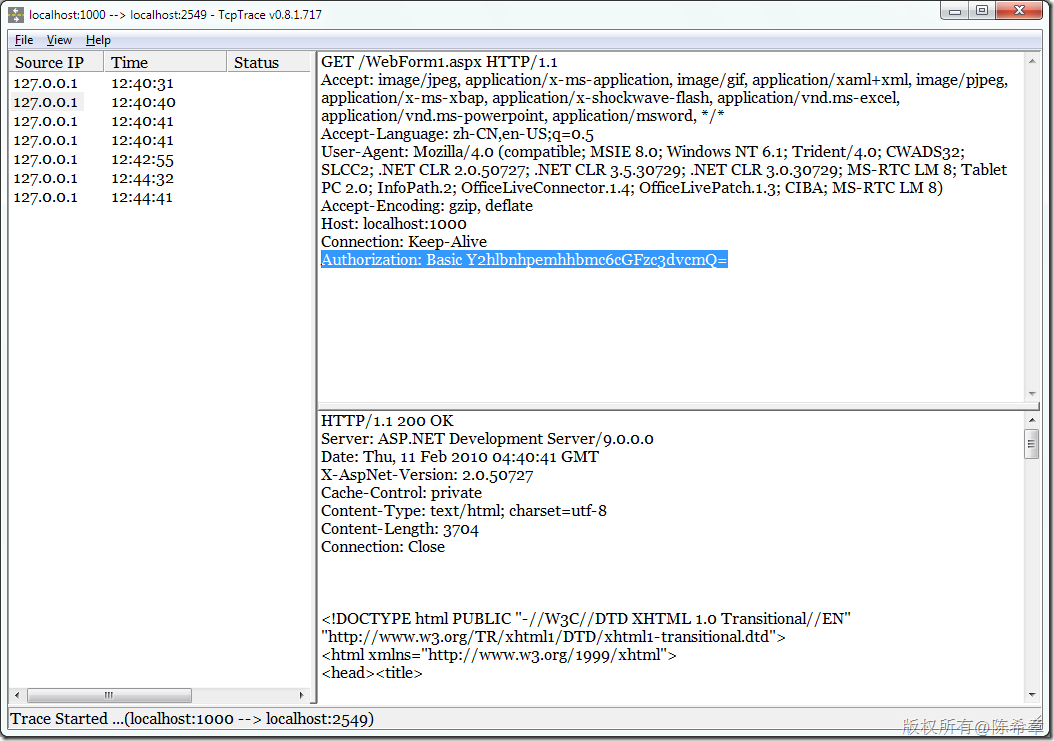这个标题可能并不太准确,我这样来描述一下我们的意图吧:
我们知道在Web应用程序中有几种主要的身份验证方式,典型的就是Windows验证和Forms验证。如果设置为Windows验证的话,那么既可以自动使用用户当前身份登录(如果在一个可信任的环境中),也可以弹出一个对话框要求用户输入用户名和密码。
再来Forms验证,顾名思义,它是有一个表单来进行验证的,在web.config中,我们通常需要指定一个loginUrl。这样用户如果没有得到授权,则需要转到这个页面输入用户名和密码。
但是,也有的朋友跟我提到,如果我们使用Forms验证,能不能也弹出一个对话框让用户输入用户名和密码呢?这的确是一个不错的问题。
可惜的是,Forms验证无法提供这样的功能,但我们确实可以通过自定义验证来实现
using System; using System.Text; using System.Web; using System.Security.Principal; namespace DataServiceAuthenticationModule { public class AuthenticationModule : IHttpModule { const string accessDeniedStatus = "拒绝访问"; const string accessDeniedHtml = "<html><body>401 您的请求被拒绝,因为没有通过身份验证</body></html>"; const string realmFormatString = "Basic realm=\"{0}\""; const string authServerHeader = "WWW-Authenticate"; const string authClientHeader = "Authorization"; const string basicAuth = "Basic"; #region IHttpModule 成员 public void Dispose() { } public void Init(HttpApplication context) { context.AuthenticateRequest += new EventHandler(context_AuthenticateRequest); } void context_AuthenticateRequest(object sender, EventArgs e) { HttpApplication context = (HttpApplication)sender; if (context.Request.Headers["Authorization"] == null) { UnAuthorization(context); } else { string credential = ASCIIEncoding.ASCII.GetString(Convert.FromBase64String(GetBase64CredentialsFromHeader())); string[] usernameandpassword = credential.Split(':'); bool isAuthenticate=Authenticate(usernameandpassword[0], usernameandpassword[1]); if (!isAuthenticate) { UnAuthorization(context); } context.Context.User= new MyPrinciple( new MyIdentity(usernameandpassword[0], isAuthenticate )); } } private static void UnAuthorization(HttpApplication context) { context.Response.ContentEncoding = Encoding.GetEncoding("GB2312"); context.Response.StatusCode = 401; context.Response.StatusDescription = accessDeniedStatus; context.Response.Write(accessDeniedHtml); // TODO: not sure this is quite right wrt realm. context.Response.AddHeader(authServerHeader, string.Format(realmFormatString, context.Request.Url.GetLeftPart(UriPartial.Authority))); } bool Authenticate(string username, string password) { //your code logic here to authenticate user if (username !="chenxizhang" || password!="password") return false; else return true; } string GetBase64CredentialsFromHeader() { string credsHeader =HttpContext.Current.Request.Headers[authClientHeader]; string creds = null; int credsPosition = credsHeader.IndexOf(basicAuth, StringComparison.OrdinalIgnoreCase); if (credsPosition != -1) { credsPosition += basicAuth.Length + 1; creds = credsHeader.Substring(credsPosition, credsHeader.Length - credsPosition); } return (creds); } #endregion } public class MyPrinciple : IPrincipal { private IIdentity _id; public MyPrinciple(IIdentity id) { _id = id; } public IIdentity Identity { get { return _id; } } public bool IsInRole(string role) { throw new NotImplementedException(); } } public class MyIdentity : IIdentity { private bool _isAuthenticated = false; private string _name; public MyIdentity(string name, bool isAuthenticated) { _isAuthenticated = isAuthenticated; _name = name; } public string AuthenticationType { get { throw new NotImplementedException(); } } public bool IsAuthenticated { get { return _isAuthenticated; } } public string Name { get { return _name; } } } }
那么,在后面到底发生了什么呢?是怎么弹出这个对话框的呢?
这个对话框其实是浏览器弹出来的。浏览器收到了一个Response,内容为Unauthorized,所以它知道服务器端需要进行验证,所以它弹出了这个对话框。为了说明这一点,我们可以来看一下其他的浏览器弹出的对话框。下面这个是Google chrome浏览器弹出的
下面这个是Mozilla Firefox浏览器弹出的
那么,接下来我们看看,我们输入的用户名和密码是怎么发送给服务器的呢
我们看到了这样一串文本:
Y2hlbnhpemhhbmc6cGFzc3dvcmQ=
这里就是包含了我们输入的用户名和密码。注意,它并没有被加密。我们可以通过下面的几行代码很容易地将其还原为明文的字符串
using System; using System.Text; namespace ConsoleApplication1 { class Program { static void Main(string[] args) { string token = "Y2hlbnhpemhhbmc6cGFzc3dvcmQ="; byte[] buffer = Convert.FromBase64String(token); string output = Encoding.ASCII.GetString(buffer); Console.WriteLine(output); Console.Read(); } } }
这是用冒号隔开的字符串。
